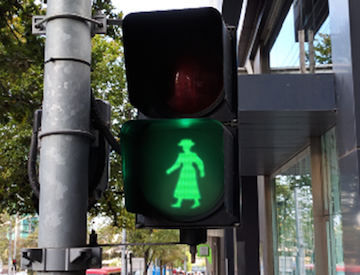The reaction to Melbourne's installation of dress-wearing symbols on traffic lights was an ugly revelation of how society views the feminine, writes Siobhan Simper.
IF YOU’VE been online at all in the past month, you can’t have missed it: the seemingly endless debate over the decision to install ten pedestrian crossings depicting figures wearing a dress in Melbourne.
The Committee for Melbourne installed the figures with the aim to “reduce unconscious bias” and make male and female public representation more equal.
If the Committee for Melbourne aimed to spark conversation around gender roles, they certainly succeeded but perhaps not in the way they intended. Social media and news outlets blew up with articles and memes about the change, unfailingly characterising the decision as “controversial” and divisive. Cries of “political correctness gone mad” were heard from the usual commentators.
Australian lobby group pushes for ‘gender-equal’ traffic light icons - read this and tell us what you think... https://t.co/In33hWo86X
— WHO Radio (@WHORadio) March 12, 2017
It was on social media that things turned nasty. One of the most frequently shared memes regarding the change was an image of three young women under a digitally altered traffic light, stolen from the Herald Sun, with text blasting the decision to spend “over $5 million” of government money to “pander to a bunch of radicals”. (The fact that the meme was shared by the page Carbon Tax. What’s Next tells you a little something about their political ideology.)
Besides portraying a group of uninvolved women who had nothing to do with the change as “radicals” – a common way to dismiss those who advocate for social change and depict their demands as unreasonable, rather than a step towards equality – the meme also established the erroneous claim that the change was costing taxpayers millions.
The fact that the $8,400 spent on the initial change was donated by Camlex Electrical, in a stance against gendered violence, seemed lost on those rapidly hitting “share” — as was the statement from the Committee for Melbourne that future changes would be cost-neutral as symbols would be updated during routine maintenance. For that matter, nearly all the actual facts about the move seemed obscured and deemed irrelevant to the flood of outrage that poured online.
Female signals on Melbourne crossings make mockery of women’s movement #auspolhttps://t.co/4KOvMp4uPB
— AXEL MIRE (@RealCranky) March 7, 2017
The decision moved from being merely controversial to “feminism at its worst”, “laughable” and (I kid you not) a “crisis of humanity”. Memes abounded, pitting those radical feminists (does this include Camlex Electrical?) against our brave soldiers, or comparing the millions Daniel Andrews was apparently prepared to spend to pacify said feminists to the pay lost to retail and hospitality workers in recent penalty rate cuts. When you consider that there actually was someone trying to make the connection between International Women’s Day (yes, this all started on IWD) and penalty rate cuts by arguing that women should be grateful for lower pay, the outrage over the traffic light figures seems confected, at best.
For the Australian Chamber of Commerce and industry’s attempts to capitalise on the historic low pay of women on the one day of the year that was specifically for women did not make the rounds on news or social media. Nor did the solid (if somewhat boring) facts about the lights. What captured the public attention was a knee-jerk negative reaction towards the feminine.
“Maleness” is the unquestioned status quo in our society. It can be argued that so much of the inequality faced by women stems from this single bias.
As the Committee for Melbourne’s CEO, Martine Letts, said:
“Unconscious bias reinforces stereotypes and influences daily decisions and attitudes.”
'Feminism at its worst': Female pedestrian crossing lights stir debate. Traffic lights are male? Come on! https://t.co/sOhbi460Cj
— Gusii (@gusiione) March 7, 2017
Unconscious bias is why women can wear trousers but men are shamed for wearing dresses and makeup; why “you play like a girl” is an insult and why fields of work typically dominated by women are grossly underpaid. That we are so conditioned to see “feminine” as less goes some way to explain the outrage, the untruths, the jokes and memes which are still circulating on my Facebook feed today.
There is certainly a debate to be had about the value of changing traffic lights to a more “feminine” appearance. We could argue about tokenism versus tangible change, whether the electrical company would have been better off donating $8,400 to a women’s shelter or other charitable organisation, and what exactly constitutes “femaleness” — as a friend said to me, “doth a dress maketh the woman?” But this was not the debate which played out on our computer screens, televisions and radios.
The “debate” was a tired one, which we have all heard repeated a million times before. It was an argument as to whether women (or by extension, the “feminine”) have a place in our society. Whether “maleness” should be challenged as the default and if any change to the status quo is considered a valuable consideration, rather than a joke. The answer we received to all these questions was a resounding “no.”
Read more from Siobhan Simper at chronicallysiobhan.com or follow her on Twitter @siobhansimper.

glad we have female traffic lights now! before, when i saw only male lights, i assumed that only men were allowed to cross, so this helps https://t.co/L2wZiUBZHG
— Left At London (@LeftAtLondon) March 19, 2017
Monthly Donation
Single Donation
Support gender equality. Subscribe to IA for just $5.











